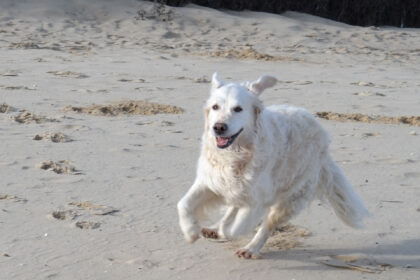
Hair loss in dogs is a common issue that concerns many dog owners. Some hair loss is normal, especially during seasonal shedding. However, if hair loss occurs suddenly, increases in intensity, or bald patches appear, it may indicate health problems. In this article, we’ll look at the possible causes and show you how to tackle the problem naturally.
Causes of hair loss in dogs
1. Seasonal shedding
Seasonal shedding is one of the most common causes of hair loss. Especially in spring and autumn, dogs shed more hair to adapt to the changing temperatures. This is perfectly normal and nothing to worry about. However, when dogs shed hair in winter, it may seem contradictory at first. However, this can often be explained by the fact that they are kept in heated rooms.
2. Allergies
Dogs can be allergic to various environmental factors such as pollen, dust mites or food. An allergic reaction can manifest itself in itching, redness and hair loss.
3. Parasite infestation
Fleas, mites and ticks can cause hair loss by irritating the skin. A common cause is the so-called flea saliva allergy, which can cause severe itching and bald patches.
4. Hormonal disorders
Diseases such as hypothyroidism (underactive thyroid) or Cushing’s syndrome (overproduction of cortisol) can lead to hair loss. These hormonal disorders affect the coat cycle and often cause symmetrical hair loss.
5. Malnutrition
An unbalanced diet can lead to nutritional deficiencies that have a negative impact on skin and coat health. A lack of omega-3 fatty acids, biotin, zinc or vitamins can cause brittle fur and hair loss.
6. Skin infections
Bacterial infections or fungal infections (e.g. dermatophytosis) can damage the skin and lead to localized hair loss. Symptoms such as dandruff, redness or weeping wounds are often accompanying symptoms.
7. Stress
Stress can also lead to hair loss in dogs. Changes in everyday life, separation anxiety or the loss of a companion can have a negative impact on the health of the fur.
8. Genetic predisposition
Some dog breeds have a genetic tendency to hair loss. For example, Chinese crested dogs or Mexican hairless dogs can naturally have less fur.
What to do if your dog loses hair?
If a dog loses more hair, the cause should be clarified. The following steps can help:
- Visiting the vet: Have the dog’s health checked to rule out serious illnesses.
- Adjusting the diet: A high-quality diet with all the important nutrients is essential for a healthy coat.
- Regular care: Brush the dog’s coat regularly to remove dead hair and stimulate the skin.
- Parasite prophylaxis: Ensure effective protection against fleas, mites and ticks.
A mindful approach to your dog’s individual needs, regular exercise, and loving companionship in everyday life can significantly contribute to maintaining your four-legged friend’s zest for life. Working with experienced professionals and adapting their living environment early on will help ensure your dog enjoys the greatest possible comfort.


The content of the articles is for general information purposes only and does not replace diagnosis or treatment by a veterinarian. Reviews or testimonials are individual reports from verified customers. This information does not constitute medical advice and should not be understood as such.
Our daily inspiration comes from the special moments with our dogs. Here we share this enthusiasm and invite you to become part of the DOG FIT community on our social media channels.


Leave a Reply